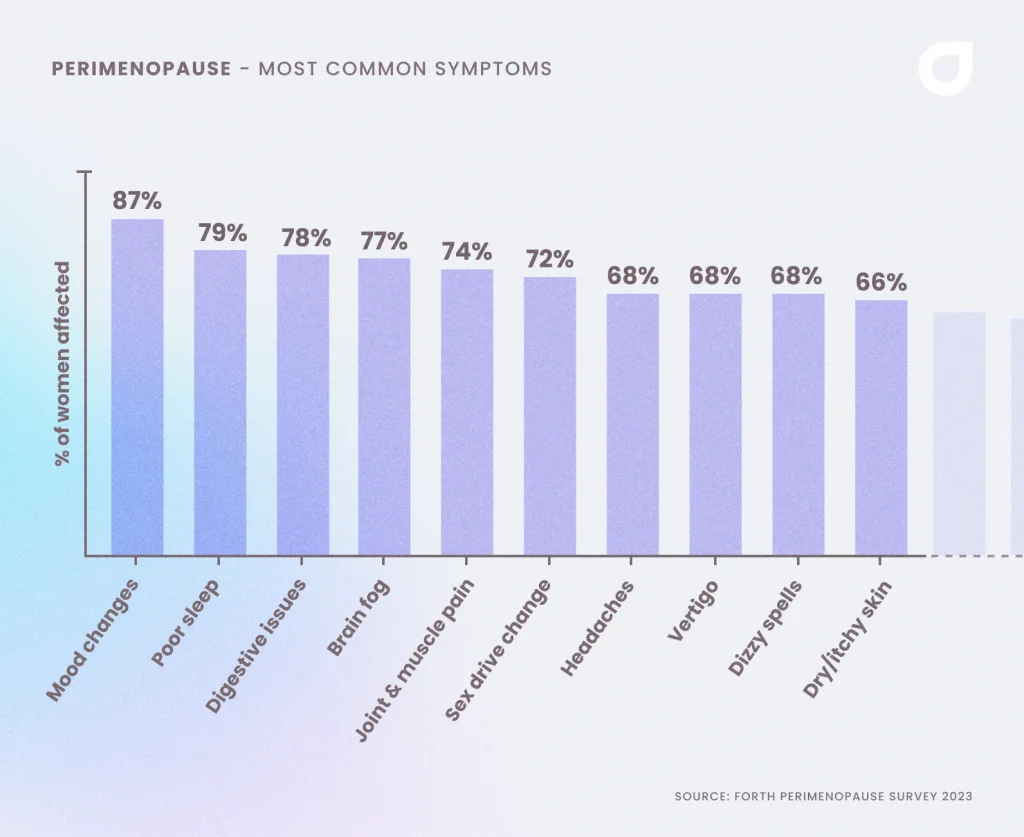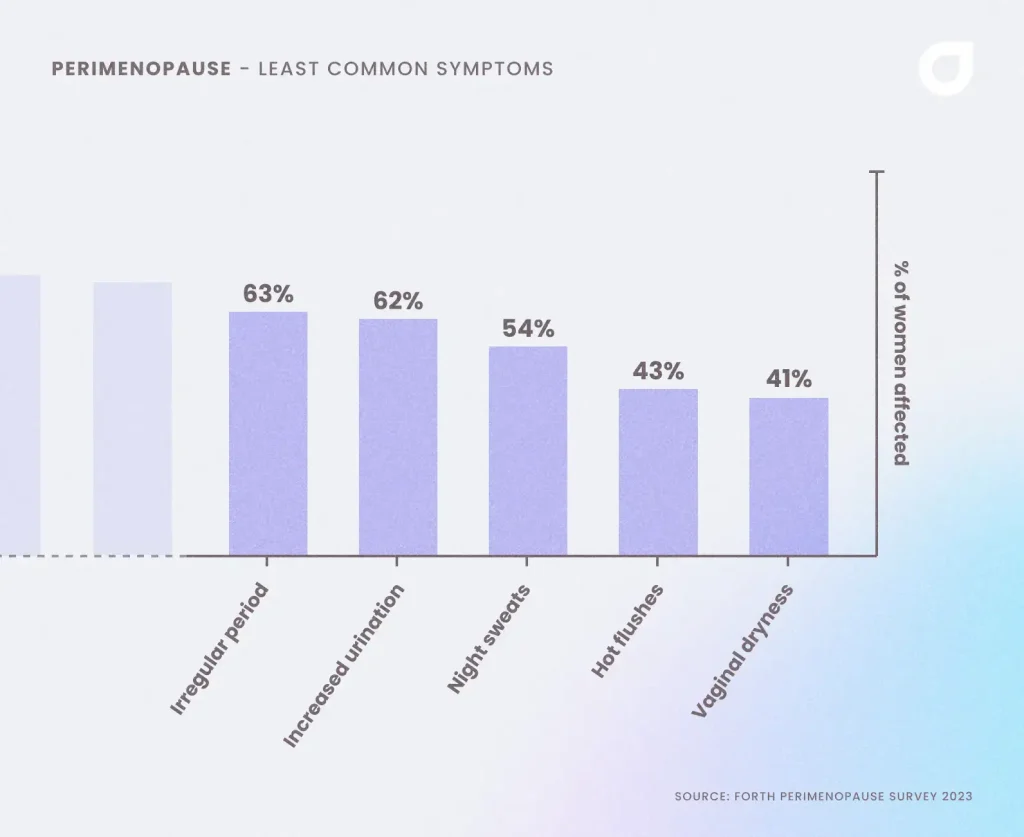6 mins read
Perimenopause Symptoms Statistics 2023

Perimenopause is one of the most under-discussed life changes. It affects all women at one stage or another. And yet we still view it as a private matter, something that we don’t ask for support for because it’s become one of the last great taboos. Meaning that for many women, it can be a lonely and difficult time.
But just like puberty, perimenopause is a natural stage in life. It is not an embarrassing disease or unusual disorder. And while, like puberty, the experience can vary from person to person, it is usually characterised by a range of symptoms, which typically begin between the ages of 40 and 44. However, for some women, perimenopause can begin much earlier or later. Symptoms can also vary in severity. For some women, symptoms can be a minor inconvenience. For others, they can be life-altering, and the experience can be deeply upsetting.
With more than 34 symptoms related to declining oestrogen levels – some, like hot flushes and night sweats being much more well-known than others – self-diagnosis isn’t always easy. And with the transition towards menopause often triggering mixed emotions – sadness at the loss of fertility, happiness at being freed from periods – women can be really reluctant to talk about their experiences or to seek a professional diagnosis.
Seeking to both remove that stigma and gain a better understanding of women’s lived perimenopause experiences, in 2022, we conducted our first perimenopause survey. Inviting the views of more than 4,000 women in their 30s, 40s, and 50s, we asked a range of in-depth questions to gain a cohesive insight into the perimenopause, and the various ways that it impacts the lives of women.
Looking to keep the conversation going and to find out even more about the subject, we’ve carried out the same Forth research in 2023, taking in the views of almost 7,000 women ranging in age from 18 to 69. These are the results.
Here are some of the main statistics at a glance
- 72% of the women aged 30-49 experienced perimenopause symptoms
- The most commonly reported symptoms of perimenopause were mood changes, poor sleep and digestive issues
- The symptoms reported the least were vaginal dryness, hot flushes and night sweats
Methodology
We questioned a total of 6,806 women on the perimenopausal symptoms they have experienced. 1,822 women were under the age of 40 and 4,984 were over the age of 40. The majority of respondents (90%) were aged between 30-49, as this is when perimenopause is most likely to occur.
The types of questions asked in the survey included whether respondents experience hot flushes, if they’ve had to deal with vaginal dryness or pain during sex and whether they are suffering from any mood changes, including increased anxiety, depression, and bursts of anger.
What are the most common perimenopause symptoms?
Mood changes, poor sleep and digestive issues were the top 3 most common symptoms.

Our research showed that 72% of our survey respondents had symptoms relating to perimenopause. And although not all of them had the same experiences, the most common symptoms were mood changes, poor sleep, and digestive issues. 87% of all respondents said that their mood had been affected by perimenopause either often or all the time. While 79% said that their sleep had been impacted, and 78% of respondents experienced digestive issues.
While it must be noted that these are relatively common symptoms, frequently experienced by younger women as well as those over 40, they are habitually associated with perimenopause. However, as perimenopause symptoms can mirror a range of other conditions, it is always a good idea to seek a perimenopause blood test to ensure an accurate diagnosis.
Other frequently experienced perimenopause symptoms
Although not in the top three reported symptoms, several other perimenopausal indicators were experienced by a high number of survey respondents.
- Both brain fog – a term which can be used to describe a range of symptoms, including poor concentration, confusion, and the feeling that you are thinking more slowly than usual – and memory issues were experienced by 77% of women
- Joint pain and muscle tension were reported by 74% of women, particularly in the 40-59 age group.
- 72% of women had noticed that their sex drive had changed
- While headaches, vertigo, and dizzy spells were either ‘often’ or ‘always’ experienced by 68% of women
- Dry or itchy skin was noted by 66% of our survey respondents

The least common symptoms of perimenopause
Despite the fact that they are the most talked about symptoms of menopause, it is interesting to note that hot flushes, night sweats, and period irregularity were among the least experienced signs reported by our survey respondents.
Five least reported perimenopause symptoms:
- Vaginal dryness – 41%
- Hot flushes – 43%
- Night sweats – 54%
- Increased urination – 62%
- Irregular period – 63%

This may mean that thousands of women are dealing with perimenopause without even realising it because they have been educated to expect symptoms that may not actually occur. And the disappointing thing is that some of these issues – hot flushes and night sweats in particular – have primarily been focused on for comedic effect rather than educational purposes.
Symptoms most frequently experienced by the under 40s
While perimenopause is most widely associated with the 40-44 age group, there are a number of linked biological changes that seem more commonly experienced by the under-40s. Vaginal dryness and pain during sex, for example, were noted by 88% of those in the 30-39 subset of the Forth survey. This age group also experienced more bloating and digestive issues (82%), lower sex drive (74%), and drier skin (71%). Although it must be noted that all of these issues, particularly dry and itchy skin, can be caused by a wide variety of factors, so must not automatically be assumed to be hormone and perimenopause-related.
Symptoms most frequently experienced by the over 50s
There were also a number of indicators more frequently experienced in the slightly older (50-59) age group. These included poor sleep (82%) and memory changes (80%), for which there can be a correlation, as well as an increase in the frequency/need to urinate (78%), irregular periods (76%), and frequent headaches, dizzy spells, and vertigo (67%).
Why symptoms alone can’t be used for diagnosis
The symptoms of perimenopause are wide-ranging and as shown in our data, can be experienced by women before and after perimenopause. This makes it hard to diagnose perimenopause solely using symptoms. However, pairing your symptoms with a blood test that checks the hormones that are directly involved in perimenopause can help you find the answers you need. Forth offer a ground-breaking blood test for women that screen for perimenopause – MyFORM Perimenopause Test. It checks the 4 key female hormones on days 14 and 21 of your cycle and maps how they change across your entire menstrual cycle. Find out more about our Perimenopause Blood Test.
Final thoughts
Perimenopause is a complicated subject matter. Because people don’t talk about it very often, there is a huge scope for misconceptions and confusion, making it much harder than it needs to be for women to take control of their own experiences and seek the help that could be available to them. At Forth, we hope that with this research, we are helping to start a very important conversation.
- Health scores calculated
Close
This information has been medically reviewed by Dr Thom Phillips
Thom works in NHS general practice and has a decade of experience working in both male and female elite sport. He has a background in exercise physiology and has published research into fatigue biomarkers.

Dr Thom Phillips
Head of Clinical Services
Related articles
Like this article? Here are some more based on similar topics.





